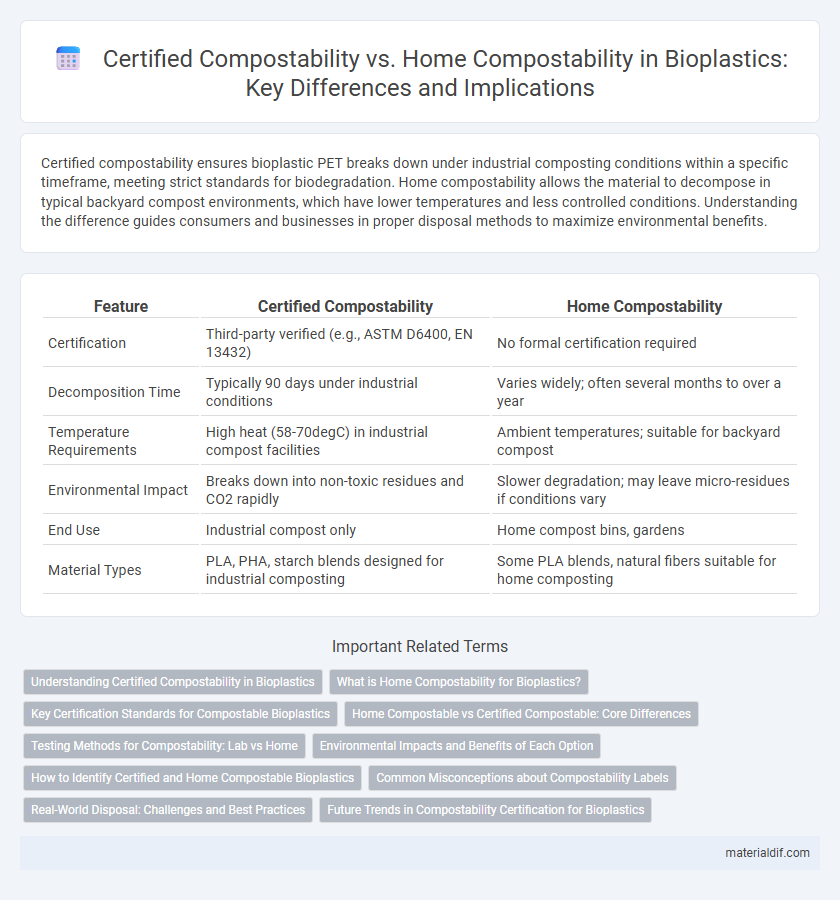Certified compostability ensures bioplastic PET breaks down under industrial composting conditions within a specific timeframe, meeting strict standards for biodegradation. Home compostability allows the material to decompose in typical backyard compost environments, which have lower temperatures and less controlled conditions. Understanding the difference guides consumers and businesses in proper disposal methods to maximize environmental benefits.
Table of Comparison
| Feature | Certified Compostability | Home Compostability |
|---|---|---|
| Certification | Third-party verified (e.g., ASTM D6400, EN 13432) | No formal certification required |
| Decomposition Time | Typically 90 days under industrial conditions | Varies widely; often several months to over a year |
| Temperature Requirements | High heat (58-70degC) in industrial compost facilities | Ambient temperatures; suitable for backyard compost |
| Environmental Impact | Breaks down into non-toxic residues and CO2 rapidly | Slower degradation; may leave micro-residues if conditions vary |
| End Use | Industrial compost only | Home compost bins, gardens |
| Material Types | PLA, PHA, starch blends designed for industrial composting | Some PLA blends, natural fibers suitable for home composting |
Understanding Certified Compostability in Bioplastics
Certified compostability in bioplastics ensures materials break down under specific industrial composting conditions, meeting standards such as ASTM D6400 or EN 13432. These certifications guarantee the bioplastic will biodegrade within a controlled timeframe without leaving toxic residues, unlike home compostability which lacks standardized conditions and may not fully degrade. Understanding these differences is critical for businesses and consumers aiming to reduce environmental impact through proper disposal and effective waste management.
What is Home Compostability for Bioplastics?
Home compostability for bioplastics refers to the ability of these materials to break down effectively in typical residential composting environments, which have lower temperatures and less controlled conditions than industrial composting facilities. Certified home compostable bioplastics must degrade within a specific time frame, often around 12 months, without leaving toxic residues or microplastics. This certification ensures that bioplastics can safely return to the soil in a backyard compost heap, supporting sustainable waste management and reducing landfill impact.
Key Certification Standards for Compostable Bioplastics
Key certification standards for compostable bioplastics include ASTM D6400 and EN 13432, which certify industrial compostability, ensuring materials break down efficiently in commercial composting facilities within 90-180 days. Home compostability certifications such as AS 5810 and TUV Austria Home Compost certify products that biodegrade under typical backyard composting conditions at lower temperatures over a longer period. Understanding the distinctions between these standards is critical for manufacturers and consumers aiming for proper disposal and environmental compliance.
Home Compostable vs Certified Compostable: Core Differences
Home compostable bioplastics are designed to break down in typical residential compost settings within a reasonable timeframe at lower temperatures, whereas certified compostable bioplastics meet stringent industrial standards such as ASTM D6400 or EN 13432 for decomposition under controlled conditions. Certified compostability requires specific environmental parameters like high heat and moisture, ensuring complete fragmentation and non-toxicity, while home compostability allows for gradual breakdown in less controlled, ambient conditions. The core difference lies in the certification process and intended composting environment, impacting the expiration timeline and suitability for various composting systems.
Testing Methods for Compostability: Lab vs Home
Certified compostability relies on standardized laboratory testing methods such as ASTM D6400 or EN 13432, which assess biodegradation, disintegration, and ecotoxicity under controlled industrial composting conditions. Home compostability testing involves differing protocols, often less stringent, evaluating biodegradation rates in variable ambient temperatures and microbial environments typical of backyard composting. Understanding these distinct testing methods is crucial for verifying if a bioplastic product can break down effectively in industrial composting facilities or in home composting setups.
Environmental Impacts and Benefits of Each Option
Certified compostability ensures bioplastics break down in industrial composting facilities within specific timeframes, reducing landfill waste and minimizing greenhouse gas emissions through controlled decomposition. Home compostability allows bioplastics to decompose in household compost settings, promoting local organic recycling and lowering transportation-related carbon footprints. Both methods support circular economy goals by enhancing soil health and reducing reliance on fossil fuels, with certified compostability offering more standardized environmental benefits.
How to Identify Certified and Home Compostable Bioplastics
Certified compostable bioplastics are identified by specific labels such as ASTM D6400, EN 13432, or OK Compost, which indicate they meet industrial composting standards. Home compostable bioplastics lack these certifications but are designed to break down in backyard compost systems with lower temperature and longer degradation time requirements. Checking product packaging for certification logos and confirming composting conditions ensures proper disposal and environmental benefits.
Common Misconceptions about Compostability Labels
Certified compostability labels indicate that bioplastics have been tested under specific industrial composting conditions, ensuring complete breakdown within standardized timeframes. Home compostability claims often lack rigorous testing and may not guarantee full decomposition in typical backyard compost setups due to varying temperature and microbial activity. Many consumers mistakenly believe all compostability labels mean the product will degrade equally in any environment, leading to improper disposal and contamination of recycling streams.
Real-World Disposal: Challenges and Best Practices
Certified compostability ensures bioplastics meet specific industrial conditions, typically requiring high temperatures and controlled humidity, which are rarely found in home composting environments. Home compostability, while more accessible, often results in slower degradation due to lower temperatures and less consistent microbial activity, posing challenges for proper disposal. Best practices involve clear labeling of bioplastic products and promoting access to industrial composting facilities to optimize real-world disposal outcomes.
Future Trends in Compostability Certification for Bioplastics
Certified compostability standards for bioplastics currently focus on industrial composting conditions, ensuring complete biodegradation within controlled environments. Future trends indicate a growing emphasis on home compostability certifications, driven by rising consumer demand for sustainable waste management solutions that function in diverse, lower-temperature settings. Innovations in biopolymer formulations and testing protocols aim to expand certification frameworks, promoting broader acceptance and environmental benefits across municipal and residential composting systems.
Certified compostability vs Home compostability Infographic

 materialdif.com
materialdif.com